The Cape White-eye is another of my favourite garden birds that is no less special for being a familiar presence in suburban gardens. Cape White-eyes forage busily in small groups and they are enthusiastic visitors to the bird baths where, after drinking, they bathe with much exuberance.
Like most white-eyes, the Cape White-eye is an adaptable species. It occurs from the coast to the mountains, preferring wooded or bushy habitats, which include parks and gardens. Small foraging parties take their time searching systematically through trees and other vegetation gleaning insects from bark, branches and from under leaves. They also hawk insects on the wing and take spiders from their webs. In addition to preying on a variety of insects and spiders they also eat fruit and nectar.
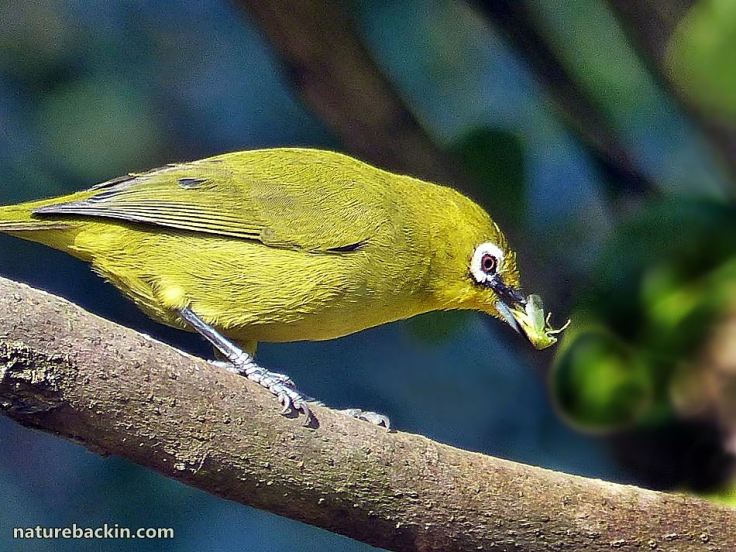
A Cape White-eye in our garden with freshly caught prey. This is the yellower form found in the north eastern parts of the country. Other forms are much greyer on the flanks.

A Cape White-eye pausing while eating the ripe fruits from a Pigeonwood tree (Trema orientalis)

This Cape White-eye is looking for anything worth gleaning in a Crossberry (Grewia occidentalis)
Belonging to the large family Zosteropidae (the family name means girdle-eye), species of white-eye, occur throughout tropical and subtropical regions in sub-Saharan Africa, Asia and Oceania. For a distribution map see here. In Australasia common names for white-eyes include silvereye and wax-eye.
Interestingly, the Japanese White-eye was introduced into Hawaii in the 1920s as a form of insect control. The highly adaptable white-eyes have become so successfully naturalised that they are now outperforming the native birds, and their high numbers are leaving native species with too little to eat (see here for more). This is another cautionary and sad tale of a deliberately introduced species becoming a threat to indigenous species.

Cape White-eyes are agile and acrobatic while searching in trees and other plants for food. This one interrupted foraging in our garden to peer at me and my camera
Three species of white-eye are found in Southern Africa – the commonest and most widespread (though absent from arid regions) is the Cape White-eye, which is endemic to Southern Africa. The African Yellow White-eye occurs in parts of Namibia, Botswana, Zimbabwe, Mozambique and the north-eastern corners of Limpopo and KwaZulu-Natal provinces, and well as in several other sub-Saharan countries further to the north. The third species, the Orange River White-eye, occurs in Namibia and along the catchment areas of the Orange and the Vaal Rivers and in adjacent regions.

I photographed this Orange River White-eye appropriately enough on the banks of the Orange River (also known as the Gariep) in the Richtersveld – at the De Hoop campsite
According to the taxonomy followed by BirdLife International, across their range there are 138 species of white-eye (see here). Because of their unusually rapid (in evolutionary terms) diversification into a large number of separate species, white-eyes were dubbed the “Great Speciators”. For an interesting account of a study investigating this phenomenon – rapid speciation of white-eyes while simultaneously spreading across new geographic regions – see this post by GrrlScientist.
Cape White-eyes remain common because they thrive in a variety of habitats, despite their mortality rates being high, as is the case for many species of birds. The annual average mortality rate for adult Cape White-eyes is 35%. In Southern Africa, predators of the Cape White-eye include the African Cuckoo-Hawk, the Common Fiscal (also known as the Fiscal Shrike) and the Fork-tailed Drongo. Being very small, adult Cape White-eyes have been found entangled in spiderwebs and even impaled on cactus thorns. Only 50% to 57% of nestlings fledge, with many falling prey to predators such as Common Fiscals, Southern Boubous and Olive Thrushes as well as to the venomous snake known as the Boomslang (literal meaning is Tree snake).

The distinctive white feathers around the eye are characteristic of most species in the Zosteropidae family
Despite being highly social birds, breeding pairs of Cape White-eyes are solitary nesters, with both parents building the nest, incubating the eggs (2 to 4 eggs per brood) and feeding and raising the young. Nests are made from a variety of mainly plant materials including lichen, dry grass stems, shreds of bark, tendrils and small roots, and the small cup-shaped nest is lined with fine grass-heads, hair or plant down. This material is bound with spiderweb that is also used to attach the nest hammock-style to a forked horizontal twig amongst the leaves of a tree or shrub. Many species of birds utilise spiderweb as an important nesting material – something to bear in mind for those who routinely eradicate spiders from their environs.
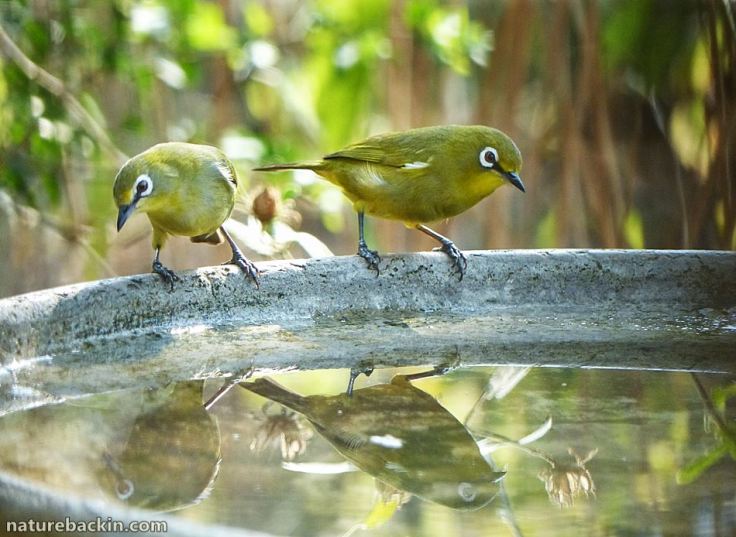
Visits to the birdbath tend to start demurely with a drink of water
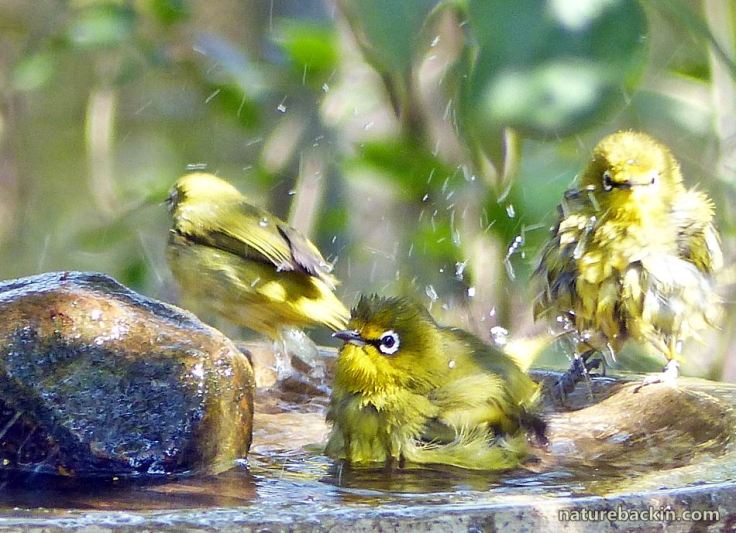
Caution soon dissipates in a flurry of splashing and dipping as bath time commences

It only gets wilder as time goes on
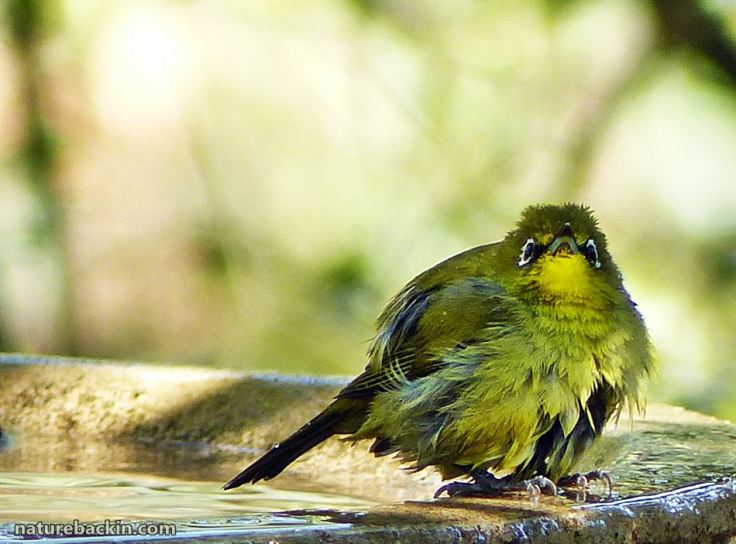
This individual seems quite overcome after participating in the bath-time flurry

And this one seems solemn and somewhat sodden
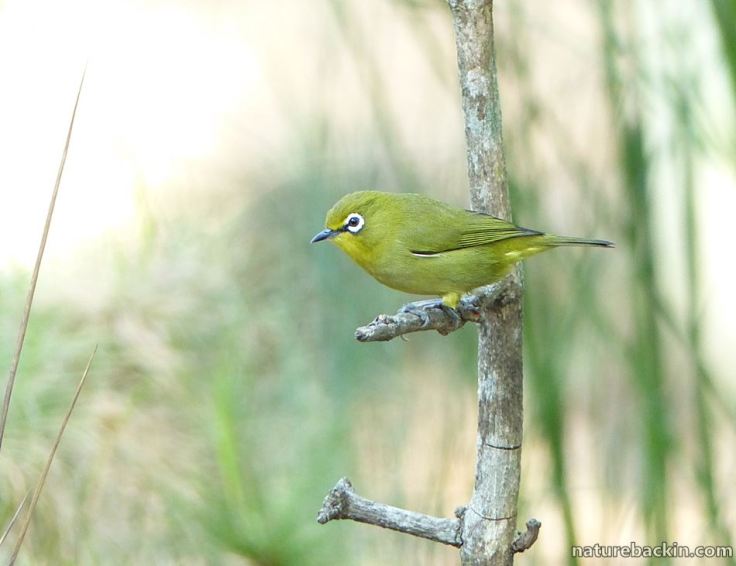
After the commotion of bathing and preening a Zen-like calm prevails before the next foraging party congregates ahead of flying off to try their luck
Sources:
Chittenden, H., Davies, G. and Weiersbye, I. 2016. Roberts Bird Guide: Illustrating nearly 1,000 Species in Southern Africa (2nd edition). Cape Town: Jacana; EurekAlert! 2009. Introduced Japanese white-eyes pose major threat to Hawaii’s native and endangered birds. https://www.eurekalert.org/pub_releases/2009-09/cp-ijw091009.php; GrrlScientist. 2009. Meet the Great Speciators: The White-Eyes. This Scientific Life. http://thisscientificlife.scientopia.org/2009/01/27/meet-the-great-speciators-the-white-eyes/; iNaturalist. 2018. White-eyes, Yuhinas, and Allies (Family Zosteropidae): Map https://www.inaturalist.org/taxa/17438-Zosteropidae; Roberts VII Multimedia PC Edition. 1997-2016 Southern African Birding. For details go to http://www.sabirding.co.za/roberts7/portal.html
Posted by Carol

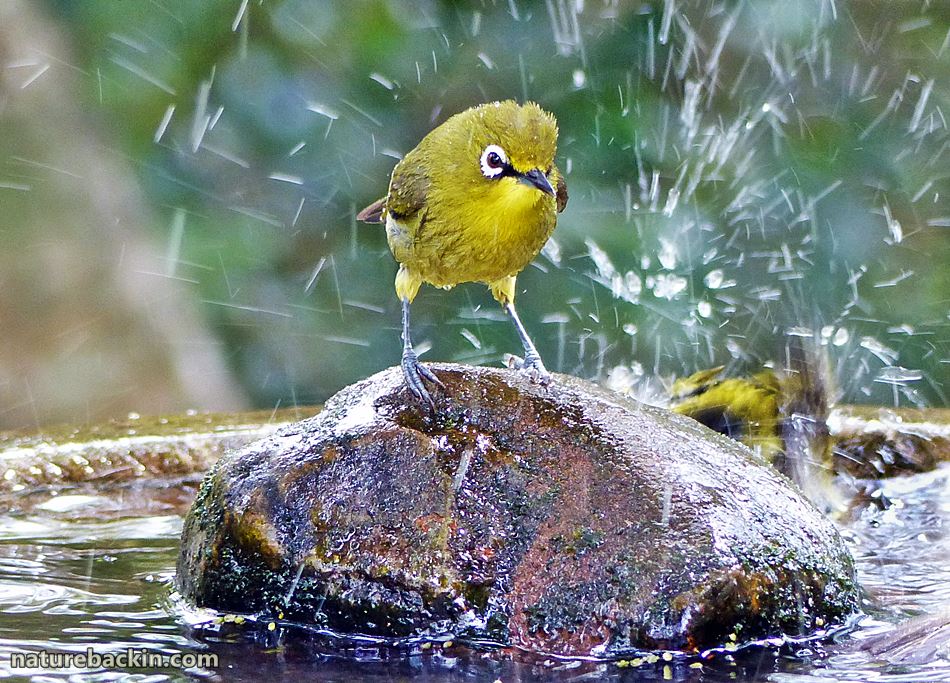





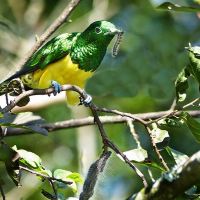
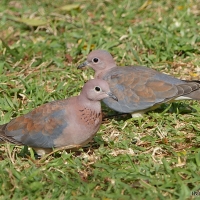
February 5, 2018 at 1:06 pm
A truly delightful post illustrated with your usual beautiful images which celebrates the life of what is to you a commonplace little bird; exotic to me! I especially love the image of them bathing: true exuberance!
LikeLiked by 1 person
February 9, 2018 at 6:11 am
Thanks Theresa. They certain do exude exuberance.
LikeLiked by 1 person
January 22, 2018 at 7:05 pm
What an engaging little bird! I love the bathing images. It reminds me of our American Robin, which delights in a good splash fest!
LikeLiked by 1 person
January 22, 2018 at 7:38 pm
Thanks Sandy. Best wishes for the New Year that is already not so new.
LikeLiked by 1 person
January 22, 2018 at 7:48 pm
And I hope your 2018 is off to a good start.
LikeLiked by 1 person
January 20, 2018 at 8:22 am
Wow! What fantastic pictures of a lovely little cute bird!! I love it ♥ May you have a wonderful year ahead, Carol! Simone
LikeLiked by 1 person
January 22, 2018 at 7:31 pm
Thank you. Yes they are very cute. And all the very best for the year ahead to you too Simone.
LikeLiked by 1 person
January 20, 2018 at 3:41 am
Beautiful photos. Our Japanese white-eyes are indeed fun to watch even if they are yet another damaging invasive species, but, hey, so am I! And they’re equally enthusiastic when bathing.
LikeLiked by 1 person
January 22, 2018 at 7:37 pm
Thanks Graham. Our cosmopolitan world is complicated!
LikeLike
January 19, 2018 at 9:11 pm
Wow! These are a stunning collection of images, Carol!
LikeLiked by 1 person
January 19, 2018 at 9:46 pm
Thanks very much Pete.
LikeLiked by 1 person
January 19, 2018 at 4:31 pm
I remember the cape white eyes! Delightful little birds with lots of character – so beautifully captured in your photographs, Carol.
LikeLiked by 1 person
January 19, 2018 at 9:44 pm
Thanks Sandra. Glad they made an impression while you were in SA. 🙂
LikeLiked by 1 person
January 19, 2018 at 4:11 pm
Once again, fantastic photos of a bird with an outsized personality. I’ve got a lot to learn about birds, but it has the appearance of the chickadees that frequent our parts.
LikeLiked by 1 person
January 19, 2018 at 9:42 pm
Thanks. It is amazing how such tiny creatures can have such presence and personality.
LikeLiked by 1 person
January 19, 2018 at 1:59 pm
Adorable indeed. Nice shots.
LikeLiked by 1 person
January 19, 2018 at 9:40 pm
Thanks very much Sherry. Glad that you find them adorable too 🙂
LikeLike
January 19, 2018 at 9:51 am
Too beautiful. Especially the Water Shots.
They are regulars at our spot but I haven’t seen any for a few weeks.
I am wondering since the recent arrival of the little Prinias in our garden if the White Eyes haven’t stepped aside for a while?
LikeLiked by 1 person
January 19, 2018 at 9:39 pm
Thanks Arc. I imagine that the persistent little Prinias could prove a challenge to the White-eyes. Hope they are back soon.
LikeLike
January 19, 2018 at 7:56 am
What wonderful photos. And what a charming bird to be able to watch so readily (even if the people of Hawaii presumably no longer think so). I’m imagining a pert, delicate bird something like our various wagtails.
LikeLiked by 1 person
January 19, 2018 at 9:34 pm
They are charming and they are pert. We get wagtails too (not sure how similar they are to the wagtails in the UK) and the White-eyes are smaller, more arboreal and agile, seemingly almost constantly flitting about usually in groups rather than in pairs.
LikeLiked by 1 person
January 19, 2018 at 4:52 am
FANTASTIC photographs of some of my favourite birds. I never tire of watching them.
LikeLiked by 1 person
January 19, 2018 at 9:26 pm
Thank so much Anne. Glad you like them too. They are always such busy little creatures perpetually on the move.
LikeLike
January 19, 2018 at 2:17 am
Wonderfully informative post, Carol. Your photos are superb and some are quite comical of this endearing little bird.
LikeLiked by 1 person
January 19, 2018 at 9:25 pm
Thank you Eliza. They are endearing little birds and they can be quite comical even if unintentionally so from their perspective 🙂
LikeLiked by 1 person
January 19, 2018 at 2:02 am
What a beauty! I am in love!
LikeLiked by 1 person
January 19, 2018 at 9:13 pm
Thanks Roda. Yes they are very lovable little birds.
LikeLiked by 1 person
January 19, 2018 at 1:39 am
Fascinating reading and tremendous photographs, Carol!
I don’t think I’ve ever taken two photos of the same white-eye – they just won’t sit still!
LikeLiked by 1 person
January 19, 2018 at 9:12 pm
Thanks very much. And you are so right about White-eyes being so active and so difficult to photograph. I have taken lots of photos that end up having no White-eye or only a portion of White-eye in the frame!
LikeLiked by 1 person
January 18, 2018 at 9:50 pm
Terrific photos Carol!
LikeLiked by 1 person
January 19, 2018 at 9:10 pm
Thanks very much Belinda.
LikeLiked by 1 person
January 18, 2018 at 8:32 pm
Awesome captures! I particularly liked the bath series. I very much enjoyed getting to know a bird I didn’t know existed. Thanks to you and WordPress! 😀
LikeLiked by 1 person
January 18, 2018 at 8:41 pm
Thanks so much Gunta. WordPress is a great enabler 🙂
LikeLiked by 1 person
January 18, 2018 at 8:29 pm
Gorgeous photos! Thank you for sharing!
LikeLiked by 1 person
January 18, 2018 at 8:36 pm
Thanks so much, Pike. Pleasure to share these lovely little birds 🙂
LikeLiked by 1 person